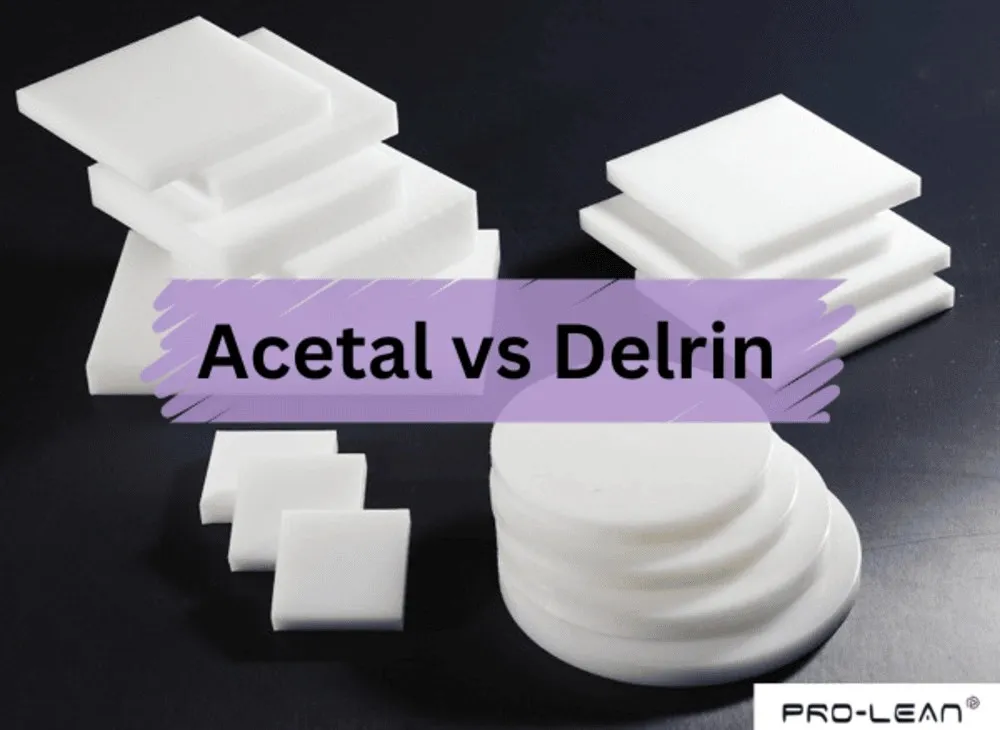
Acetal vs. Delrin: Material Comparison
Have you been confused about choosing between Delrin and Acetal? It is quite a daunting task to determine which one is best suited for a particular application.
Due to their exceptional strength and resistance, Acetal and Delrin are the polymers widely used in the manufacturing industry. However, Delrin works best for CNC machining as its mechanical properties make it highly impactful.
Prolean Tech specializes in plastic CNC machining, transforming raw materials into precisely shaped metal and plastic parts for various industries.
This blog post provides a comprehensive overview of Acetal vs. Delrin, helping you make an informed choice. So, let’s get into the topic.
Delrin vs Acetal – Core Differences in Structure and Performance
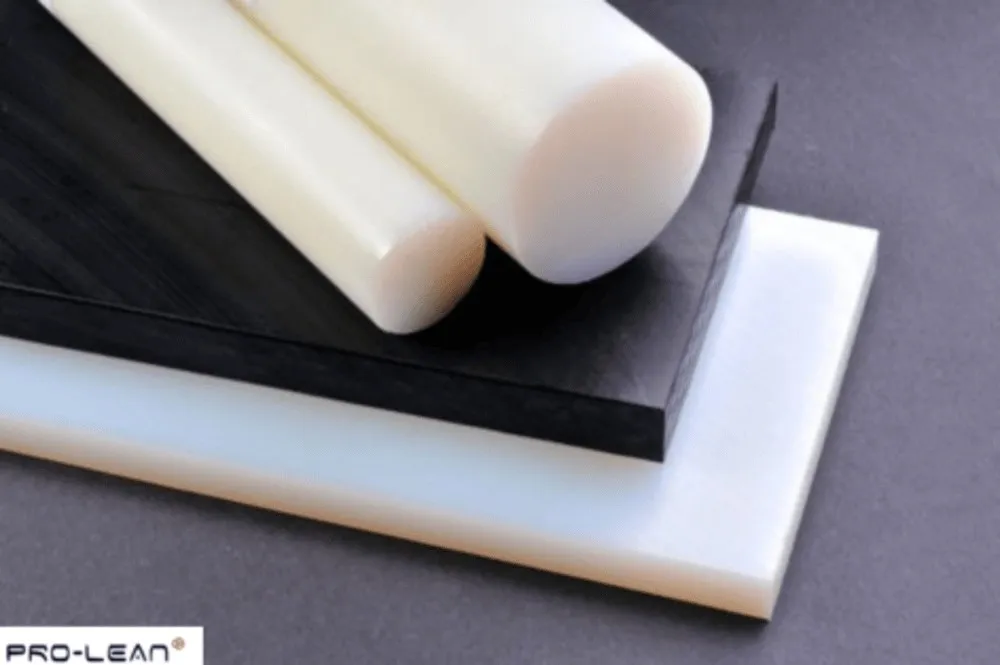
Delrin vs. Acetal with Structural and Performance Differences
Before getting into the differences of Acetal vs Delrin, let’s have an overview of these manufacturing polymers.
Acetal is a semi-crystalline thermoplastic that is either a copolymer or a homopolymer. This copolymer is a chain of CH2O molecules, but the extra comonomers disrupt the chain after every 70–100 units of CH2O. This disruption makes the material less crystalline.
Acetal polymers can easily integrate with other materials through coupling that improves their properties.
On the other hand, Delrin is a homopolymer acetal with a uniform backbone of CH2O units. This makes it possible to create larger crystalline blocks than other POMs. The unique properties of Delrin, like staying intact even if the temperature changes, make it a widely used material.
Read out about plastic product prototype to get more clarity.
Here are the core differences in the structure and performance of these two manufacturing polymers:
| Factor | Acetal (Copolymer) | Delrin (Homopolymer) |
| Structure | Made of multiple polymer chains, improving chemical resistance and stability | Single polymer chain, offering higher strength and stiffness |
| Molecular Composition | Copolymer structure reduces internal stress and warping | Homopolymer structure makes it stronger but prone to shrinkage |
| Crystallinity | Slightly lower crystallinity, giving better dimensional stability | Higher crystallinity, leading to better mechanical properties |
| Performance | Better moisture and chemical resistance, ideal for wet environments | Superior mechanical strength and wear resistance, better for high-load applications |
| Wear & Friction | Lower wear resistance, but sufficient for moderate loads | Higher wear resistance, ideal for high-friction parts |
| Impact Strength | More flexible and impact-resistant | More rigid, but slightly brittle under impact |
| Thermal Stability | Better long-term heat resistance, less thermal degradation | Higher short-term heat resistance, but degrades faster over time |
Try Prolean Now!
Acetal Copolymer vs Delrin – When to Choose Which?
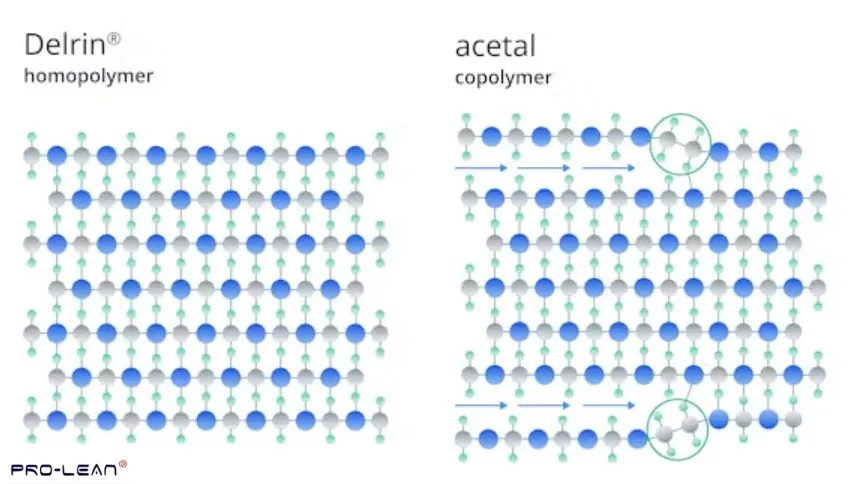
Delrin vs. Acetal: Molecular Structures
Here is the one-on-one comparison to know the properties of Acetal vs Delrin and make better decisions:
| Property | Acetal (Copolymer) | Delrin (Acetal Homopolymer) |
| Density | ~1.41 g/cm³ | ~1.42 g/cm³ |
| Melting Point | ~165°C (329°F) | ~175°C (347°F) |
| Tensile Strength | Lower than Delrin (~60 MPa) | Higher (~70 MPa) – more rigid and stronger |
| Thermal Stability | Better long-term heat resistance | More prone to thermal degradation |
| Chemical Resistance | More resistant to hot water and strong chemicals | Slightly weaker resistance to chemicals and moisture |
| CNC Machinability | Easier to machine, less prone to warping | Machines well but may experience internal stress and shrinkage |
Based on these properties, it’s evident that both materials have applications in the manufacturing industry. From injection molding to 3D printing and plastic CNC machining, Delrin and Acetal are used to make automotive parts, electric insulators, and packaging material, among others.
However, they have applications based on their specific properties, too. Delrin is suitable for parts that require strong POM material. On the other hand, acetal has applications where a high chemical resistance polymer is needed.
Now that we have found the key differences of Delrin vs Acetal, scroll down to see why Delrin is perfect for CNC machining.
Delrin Plastic Properties – Why It’s a CNC Machining Favorite
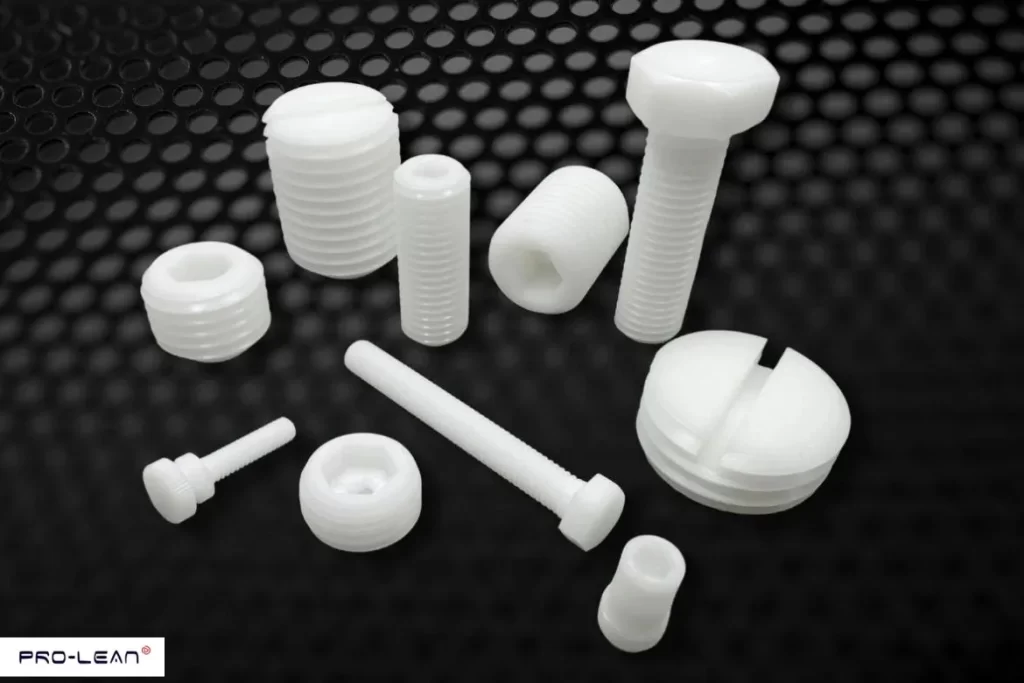
Acetal/Delrin Components
When talking about acetal copolymer vs Delrin, Delrin has a wide range of applications in CNC machining due to its strength, precision, and excellent mechanical properties. It offers high tensile strength (~70 MPa) and rigidity.
Besides this, Delrin has low friction and excellent dimensional stability, which means it maintains its shape and size even under mechanical stress or varying environmental conditions. Its resistance to moisture, solvents, and creep further enhances its reliability in precision engineering applications.
All these factors make it a perfect choice for high-load applications. Delrin has high wear resistance that makes it perfect for gears, bearings, and sliding components that require durability and smooth movement.
Another key advantage of Machining Delrin in CNC machining is its machinability. It cuts cleanly, holds tight tolerances, and doesn’t produce excessive tool wear. Besides this, it has low moisture absorption. Therefore, the material does not deform under humid conditions.
Additionally, Delrin offers good heat and chemical resistance, with a melting point of ~175°C (347°F). It can withstand fuels, solvents, and mild acids, making it suitable for automotive, medical, and industrial applications.
Based on all these characteristics, Delrin’s applications in CNC machining include bushings, fasteners, rollers, electronic housings, and fuel system components. Due to its high strength and precision, Delrin remains a top choice for manufacturers needing high-performance plastic parts, including plastic molding products.
Advanced Plastic Machining Techniques for High-Performance Polymers
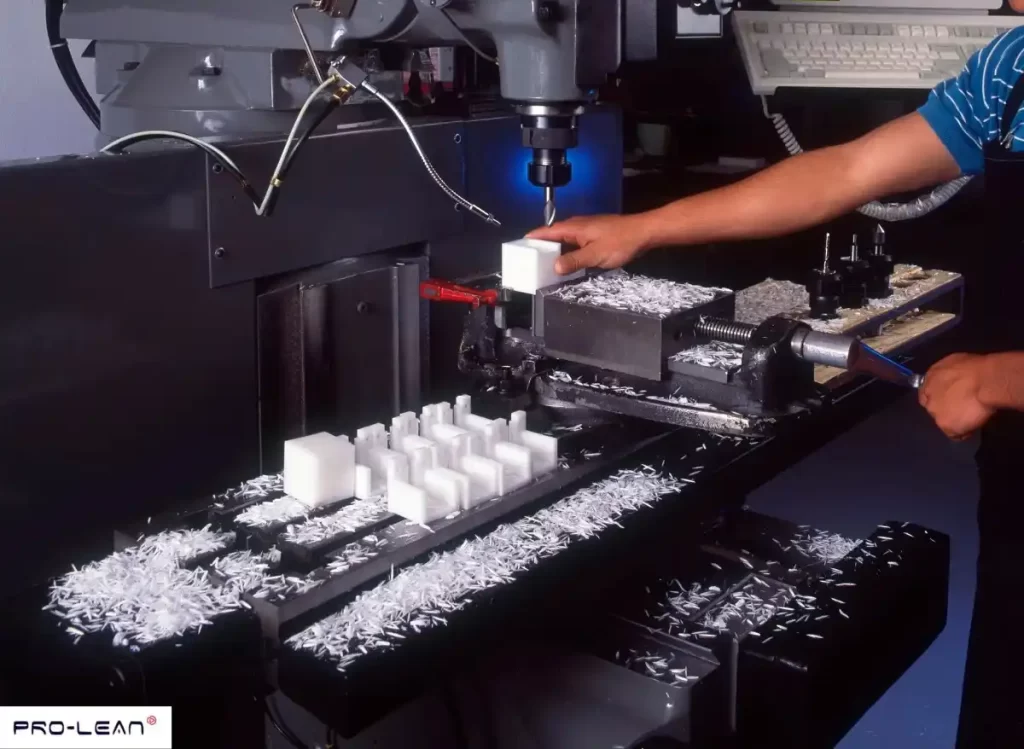
Machining Acetal/Delrin with CNC Mill
Get to know these advanced plastic extrusions and machining techniques for high-performance polymers:
- When using Delrin, make sure you use high-speed CNC machining as it improves efficiency and precision when working with tough polymers like PEEK and Delrin.
- Cryogenic cooling prevents heat buildup, reducing material warping and improving the surface finish.
- Ultrasonic machining allows for the precise cutting of delicate or high-strength plastics without excessive tool wear.
- Laser machining offers extreme accuracy for intricate designs, minimizing stress on the material.
- Post-machining annealing reduces internal stresses, enhancing dimensional stability and long-term performance. So, it’s highly recommended.
- Specialized tooling and coatings (like diamond-coated tools) extend tool life and improve the cutting of abrasive plastics.
- Hybrid machining methods that combine CNC milling with additive manufacturing optimize part complexity and strength.
Try Prolean Now!
Plastic CNC Machining Tips for Acetal and Delrin
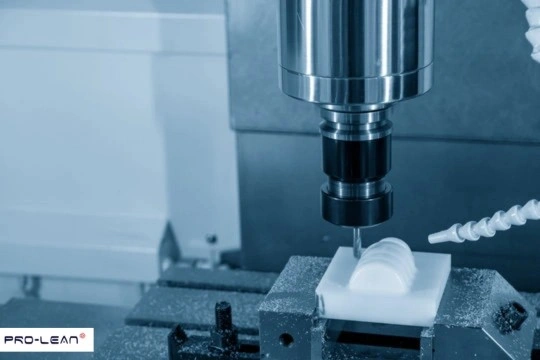
Precision Machining of Delrin/Acetal
Here are some CNC machining tips for Acetal and Delrin:
- Use sharp tools to assure a refined final product with minimal deformations.
- Optimize the feed and speed rate of the machine to avoid melting.
- Use a chip breaker to cut long, stringy chips of Acetal and Delrin.
- Since both are plastic polymers and can expand with heat, machine them with tight tolerance in mind.
- Use light sanding or buffing to enhance the high-end surface finish.
Wrap Up
Therefore, choosing between Acetal and Delrin is crucial when creating high-performance parts. Each polymer offers various advantages depending on your specific application requirements.
Acetal works better with chemicals and provides dimensional stability. At the same time, Delrin offers exceptional strength, wear resistance, and machinability, making it perfect for high-load applications in the automotive, medical, and construction industries.
However, picking the right one saves money and ensures long-term reliability. At ProleanTech, we are aware of these critical material differences and can help you make the best choice for your specific needs.
Our plastic machining services create precise parts that meet your exact specifications. When your projects require high-quality finished products with tight tolerances, contact ProleanTech to transform your manufacturing challenges into solutions.
FAQs
Q1. Are acetal and Delrin the same thing?
While Delrin and acetal share some similarities, there are also key differences. Acetal can be produced as either a homopolymer or copolymer, while Delrin is exclusively a homopolymer. Delrin also features higher tensile strength, making it ideal for structure models.
Q2. Which is better, nylon or Delrin?
Both are strong plastics, but they shine in different areas. Delrin is smoother, making it great for parts that slide or need low friction. Nylon, however, is tougher and more resistant to wear and moisture. If you need a strong, lightweight material, nylon is better. But for smooth, precise movement, Delrin is the top option.
Q3. What is the main difference between acetal and Delrin?
Acetal refers to a group of plastics, while Delrin is a specific type of acetal with better strength. Delrin has higher toughness and resistance, making it ideal for mechanical parts. Standard acetal is still strong, but Delrin is a premium option. So, all Delrin is acetal, but not all acetal is Delrin!
Q4. Can Delrin replace metal in high-stress applications?
Delrin is strong, but metal is still better for extreme stress. Delrin can replace metal, like gears, bearings, and machine parts, because it’s lightweight and resistant to wear. However, metal is still the best choice for heavy loads or very high temperatures. Delrin is great, but it has its limits!

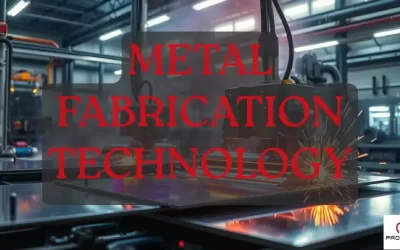

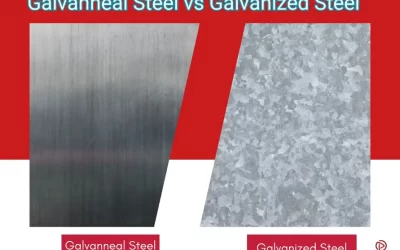
0 Comments